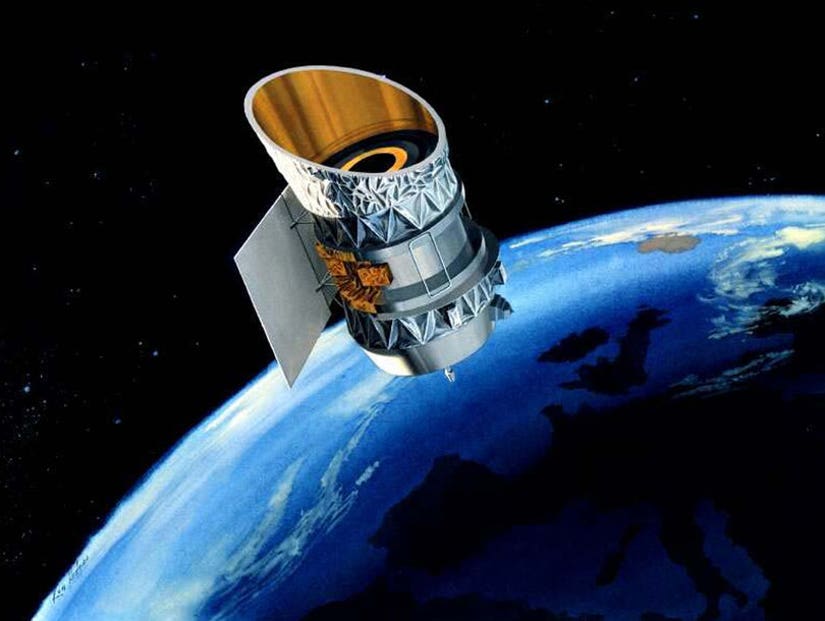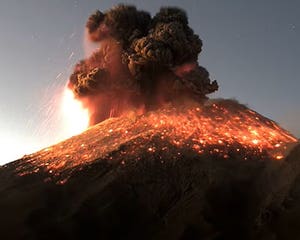 NASA (pictured: IRAS)
NASA (pictured: IRAS)
They're set to pass VERY close to each other above Pittsburgh at 6.39PM EST tonight.
A pair of satellites could smash into each other above the U.S. on Wednesday night.
LeoLabs, which tracks space debris, has warned that two dead satellites are hurtling toward each other at around 32,883 MPH, and are currently predicted to scrape past each other with a gap of just 39 feet — a hair's breadth in terms of space space.
The collision probability, which is fluctuating all the time, currently stands at just 1 in 20 — revised from 1,000 to 1 earlier this week.
 CBS All Access
CBS All Access
Star Trek: Picard Premiere Echoes Our Darker, Less Trusting World as Jean-Luc Finds Reason to Fight
View StoryThe potential point of impact is 559 miles straight above Pittsburgh, Pennsylvania, at 6.39PM EST.
LeoLabs said the two objects are IRAS, a decommissioned space telescope launched in 1983, GGSE-4, an experimental U.S. payload launched in 1967.
Because both are dead, there is no way of communicating with them to potentially steer them away from each other. Due to their high velocity, they only need to touch each other for them both to disintegrate into thousands upon thousands of little pieces.
2/ The 12m total miss distance has components of:
@LeoLabs_Space
11m radially
0m in-track
5m cross-track
We can visualize this conjunction geometry from the top-down and side-on views of the event at TCA: pic.twitter.com/Vo1fRPE2yH
If they do collide, there is no danger to Earthlings, as no debris would ever reach the surface of the planet. The danger they do pose however, is for everything else in orbit.
"The worry is that we'll start seeing a chain reaction where all the satellites kill each other with shrapnel and space becomes unusable," Harvard-Smithsonian Center for Astrophysics astronomer Jonathan McDowell told CNN.
"People need to care about this because we depend on space for a lot of things nowadays, so even if you never go to space you're using space technology, with things like GPS, internet, and satellite communications. So there's a lot of concern."
He said the energy produced by a collision would be the equivalent of a one ton truck hitting a person at 100 miles an hour, times 100,000.
 YouTube
YouTube
Spectacular Popocatépetl Volcano Eruption Caught on Webcam
View StoryLeoLabs CEO Dan Ceperley said that the 60+ space agencies currently operating around the world need to work together to develop the best practices and create a sustainable economy before we continue our rapidcommercialization and expansion into space.
"It's just like the oceans. Humans started off thinking 'this is big and empty, we can throw any rubbish we like in it and it'll never be a problem,'" he said. "It's only when things get really bad and almost too late to fix that we start getting worried."
As of October 2019, the US Space Surveillance Network reported nearly 20,000 artificial objects in orbit above the Earth, including more than 2,200 operational satellites. However, these are only objects big enough to be tracked; there are another estimated 34,000 pieces of debris larger than 10cm, 900,000 pieces of debris between 1cm and 10cm, and 128million pieces of debris smaller than 1cm in orbit around the Earth.
Even the smallest man-made objects - such as flecks of paint - can, when moving at such speed, cause damage akin to sandblasting to other satellites.
The potential devastation from a ripple effect event is depicted in the Oscar-winning film "Gravity", when a Russian missile strike on a defunct satellite forms a rapidly expanding cloud of space debris that cripples Sandra Bullock's ship and kills her crew.
Got a story or a tip for us? Email TooFab editors at tips@toofab.com.
 Getty/Facebook
Getty/Facebook



















